#Confuciusornithidae
Text
Paleontólogos hallan el fósil de un ave con pico de 119 millones de años de antigüedad
A partir de un esqueleto casi completo hallado en el noreste de China se ha identificado una nueva especie de ave confuciusornítida a la que se ha dado el nombre de Confuciusornis shifan.

Confuciusornis shifan vivió en lo que hoy es China durante el Cretácico Temprano, hace unos 119 millones de años.
La nueva especie pertenecía a Confuciusornis, un género extinto de aves con pico del tamaño de un cuervo de la familia Confuciusornithidae.
Confuciusornis shifan pesaba menos de 200 gramos y era más pequeño que la mayoría de las demás especies de confuciusornítidos.
"Confuciusornithidae es un clado de aves pigostíleas del Cretácico Temprano conocidas en la biota Jehol de Asia Oriental, y representa a las primeras aves sin dientes y con pico conocidas", explican los paleontólogos de la Universidad Normal de Shenyang Dongyu Hu y Xing Xu y sus colegas de China y Canadá.
"Se han descrito y asignado a esta familia cinco géneros y once especies, recuperados de las formaciones Dabeigou, Yixian y Jiufotang, aunque la validez de algunas especies es cuestionable".
"Están representados por miles de especímenes excepcionalmente conservados que proporcionan colectivamente una rica información sobre la morfología, taxonomía, capacidad de vuelo, crecimiento, dieta y ecología de los confuciusornítidos."
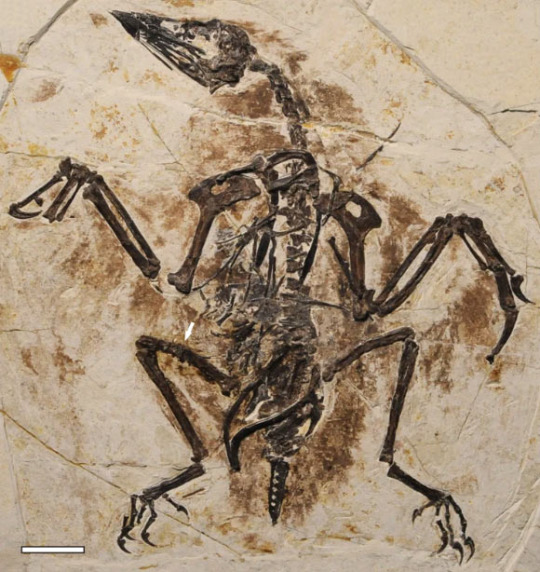
El esqueleto casi completo y articulado, conservado en una única losa, de Confuciusornis shifan fue recuperado de la Formación Jiufotang, cerca de la aldea de Xiaotaizi, en la provincia china de Liaoning.
"En comparación con otros confuciusornítidos, esta nueva especie y la recientemente descrita Yangavis confucii muestran evidencias de una mayor capacidad de vuelo, aunque las alas de las dos especies difieren entre sí en muchos aspectos", afirman los investigadores.
"Nuestros análisis aerodinámicos en el marco de la filogenia indican que diversos modos de adaptación al vuelo surgieron a través de la diversidad de confuciusornítidos, y en menor grado en el curso de su ontogenia, y sugieren específicamente que tanto una tendencia hacia la mejora de la capacidad de vuelo como un cambio en la estrategia de vuelo se produjeron en la evolución de los confuciusornítidos."
"Confuciusornis shifan difiere de manera más destacada de otras aves mesozoicas por tener un hueso extra en forma de almohadilla en el primer dígito del ala, una característica muy inusual que puede haber ayudado a satisfacer las demandas funcionales del vuelo en una etapa en la que el crecimiento del esqueleto era aún incompleto", concluyeron.
"El nuevo hallazgo ejemplifica de forma sorprendente la diversidad morfológica, de desarrollo y funcional de las primeras aves con pico".
Referencia:
Wang, R., Hu, D., Zhang, M. et al. A new confuciusornithid bird with a secondary epiphyseal ossification reveals phylogenetic changes in confuciusornithid flight mode. Commun Biol 5, 1398 (2022). https://doi.org/10.1038/s42003-022-04316-6
0 notes
Text
u can really tell i ran out of steam writing this essay bc i wrote a ton abt the evolution of feathers like vaned vs downy, symmetric vs asymmetric vanes, etc and then when i got to the last bit i could barely write a paragraph like . birds have uhhhhhhh weird wrists?? so the... semilunate carpals like... make their arms fold like a wing... something something aerodynamics
#if i have time i will fix it but now i have to write 2 pages on sabertooth adaptations and 3 pages on whale evolution :(#adhd brain why did u do nothing but read tangentially related articles abt paravian respiration#it wasnt even interesting my brain jsut refused to let me say an article wasnt relevant t omy paper unless i read the whole thing#.txt#if i have to type confuciusornithidae one more time i will go apeshit
1 note
·
View note
Text
Eoconfuciusornis zhengi
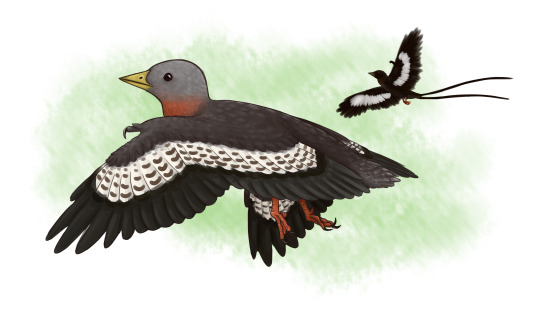
By Scott Reid on @drawingwithdinosaurs
PLEASE SUPPORT US ON PATREON. EACH and EVERY DONATION helps to keep this blog running! Any amount, even ONE DOLLAR is APPRECIATED! IF YOU ENJOY THIS CONTENT, please CONSIDER DONATING!
Name: Eoconfuciusornis zhengi
Name Meaning: Dawn Confucius Bird
First Described: 2008
Described By: Zhang, Zhou & Benton
Classification: Dinosauria, Theropoda, Neotheropoda, Averostra, Tetanurae, Orionides, Avetheropoda, Coelurosauria, Tyrannoraptora, Maniraptoriformes, Maniraptora, Pennaraptora, Paraves, Eumaniraptora, Averaptora, Avialae, Euavialae, Avebrevicauda, Pygostylia, Confuciusornithiformes
Eoconfuciusornis is an Avialan that lived about 131 million years ago, in the Haquterivian age of the Early Cretaceous - making it older than Confuciusornis, its relative, leading to its name. It had a pointed, toothless snout, but this snout was probably not homologous (meaning, having the same evolutionary origin) as modern bird beaks, given that many birds more derived than Eoconfuciusornis retained teeth. It is, however, the oldest known Avialan to have a beak. It is from the Dabeigou Formation in Hebei Province, China, and it is known multiple fairly complete skeletons, including a female in the early process of generating new eggs. Eoconfuciusornis was smaller than Confuciusornis, and it had longer legs and lacked a crest on the humerus, unlike Confuciusornis.
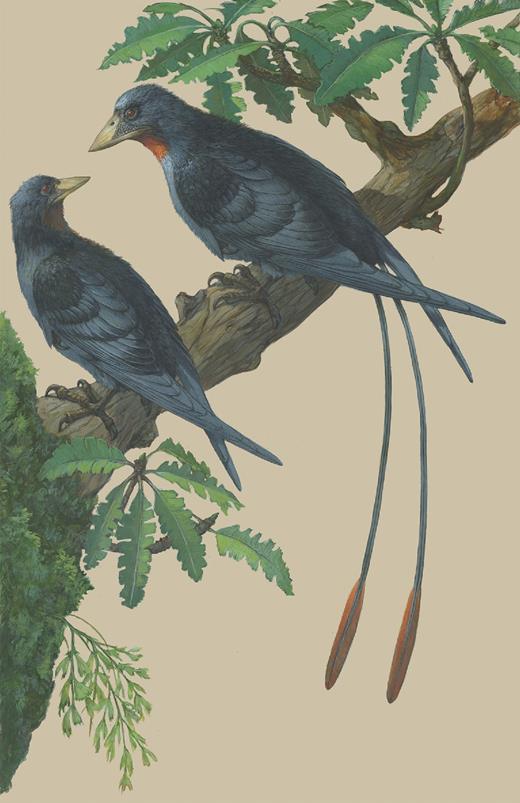
By Michael Rothman, taken from Zheng et al. 2017.
It is the most early derived member of the Confuciusornis family group (which is called Confuciusornithidae or Confuicusornithiformes, depending on the context, so I’m just going to keep calling it the family group.) It had a triangular head, and pointed but broad wings, indicated it was well built for gliding, as well as ribbon tail feathers that would probably have been used for display, seeing as they were sexually dimorphic. Some coloration is known from the fossil female, which does not preserve the ribbon feathers (indicating the aforementioned sexual dimorphism); it’s difficult to completely construct the coloring, but the females were probably mostly black, with a brown throat patch, grey head and legs, and darkly spotted wings.
Source:
https://en.wikipedia.org/wiki/Eoconfuciusornis
Martyniuk, M. P. 2012. A Field Guide to Mesozoic Birds and other Winged Dinosaurs. Pan Aves; Vernon, New Jersey.
Zheng, X., J. K. O’Connor, X. Wang, Y. Pan, Y. Wang, M. Wang, Z. Zhou. 2017. Exceptional preservation of soft tissue in a new specimen of Eoconfuciusornis and its biological implications.
Shout out goes to @jamieraptor!
#eoconfuciusornis#eoconfuciusornis zhengi#dinosaur#bird#palaeoblr#birblr#jamieraptor#paleontology#prehistory#prehistoric life#dinosaurs#biology#a dinosaur a day#a-dinosaur-a-day#dinosaur of the day#dinosaur-of-the-day#science#nature#factfile#Dìneasar#דינוזאור#डायनासोर#ديناصور#ডাইনোসর#risaeðla#ڈایناسور#deinosor#恐龍#恐龙#динозавр
94 notes
·
View notes
Photo

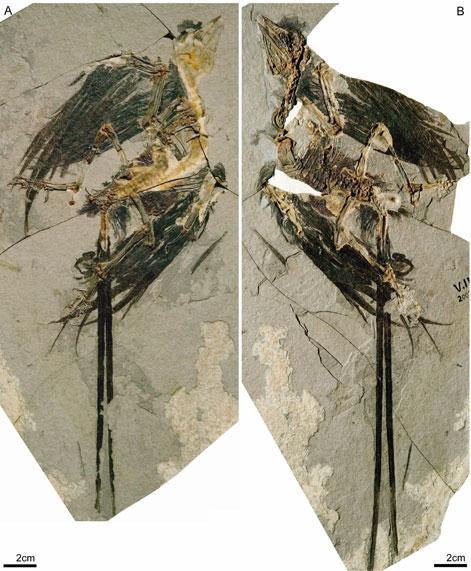
Econfuciusornis zhengi
...a species of confuciusornithiform bird that lived in Early Cretaceous China. Like other members of Confuciusornithidae E.zhengi possessed both shafted and non-shafted feathers and was capable of flight, it probably acted similar to modern birds. E.zhengi was smaller than the famous Confuciusornis it also had longer legs and lacked a pierced deltopectoral crest on the humerus.
Phylogeny
Animalia-Chordata-Aves-Confuciusornithiformes-Confuciusornithidae-Econfuciusornis-E.zhengi
Images: Nobu Tamura and University of Bristol
#Econfuciusornis zhengi#Dinosaur#Aves#Confuciusornithiformes#Confuciusornithidae#Econfuciusornis#birds are dinosaurs#Dinosauria#Birds#Cretaceous#China#Asia#Extinct
393 notes
·
View notes
Text
Changchengornis hengdaoziensis
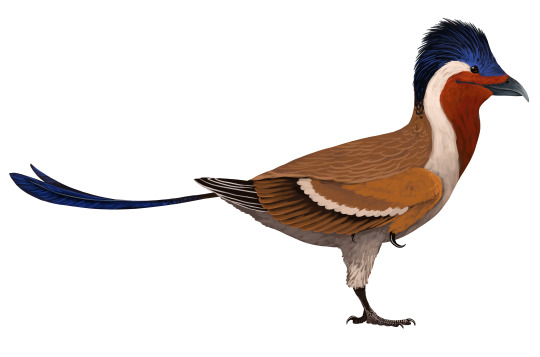
By Jack Wood on @thewoodparable
PLEASE SUPPORT US ON PATREON. EACH and EVERY DONATION helps to keep this blog running! Any amount, even ONE DOLLAR is APPRECIATED! IF YOU ENJOY THIS CONTENT, please CONSIDER DONATING!
Name: Changchengornis hengdaoziensis
Name Meaning: Great Wall Bird
First Described: 1999
Described By: Ji, Chiappe & Ji
Classification: Dinosauria, Theropoda, Neotheropoda, Averostra, Tetanurae, Orionides, Avetheropoda, Coelurosauria, Tyrannoraptora, Maniraptoriformes, Maniraptora, Pennaraptora, Paraves, Eumaniraptora, Averaptora, Avialae, Euavialae, Avebrevicauda, Pygostylia, Confuciusornithiformes, Confuciusornithidae
Changchengornis is a relative of Confuciusornis, a Confuciusornithid, from the Yixian Formation of Liaoning, China, living about 124.8 million years ago, in the Aptian age of the Early Cretaceous. It differed from Confuciusornis in a few ways, including a more pointed snout with a long and hooked end, which may indicate a difference in feeding preferences from Confuciusornis. However, this isn’t exactly a very helpful detail, seeing as the diet of Confuciusornis itself is a mystery. It was a very small dinosaur, with a wingspan of only about 42 centimeters and a body length of 20 centimeters. Its wings, therefore, were fairly short, but were also quite broad.
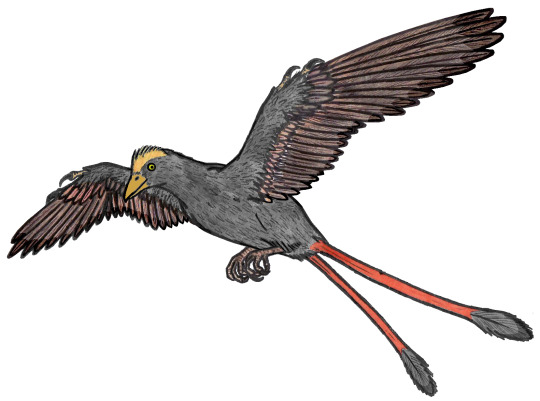
By Conty, CC BY 3.0
It is known from a single specimen that showed the ribbon tail feathers which are known from Confuciusornis. As such, it indicates that it used its tail for display, probably sexual display, and the specimen found is probably a male, based on display patterns in modern birds. It is known from a largely complete, articulated, but damaged skeleton, with other preserved feathers besides the tail ones. It had a tuft of feathers on its head for a crest, and it may have resembled modern turacos. It was better adapted for perching in trees than other early birds, but it wouldn’t have been able to maneuver well in dense forests. It would have relied on gliding primarily, rather than flapping flight.
Sources:
https://en.wikipedia.org/wiki/Changchengornis
Martyniuk, M. P. 2012. A Field Guide to Mesozoic Birds and other Winged Dinosaurs. Pan Aves; Vernon, New Jersey.
http://mpm.panaves.com/nh/changchengornis.htm
Shout out goes to @smokeytyto!
#changchengornis#changchengornis hengdaoziensis#bird#dinosaur#birblr#palaeoblr#smokeytyto#paleontology#prehistory#prehistoric life#dinosaurs#biology#a dinosaur a day#a-dinosaur-a-day#dinosaur of the day#dinosaur-of-the-day#science#nature#factfile#Dìneasar#דינוזאור#डायनासोर#ديناصور#ডাইনোসর#risaeðla#ڈایناسور#deinosor#恐龍#恐龙#динозавр
50 notes
·
View notes